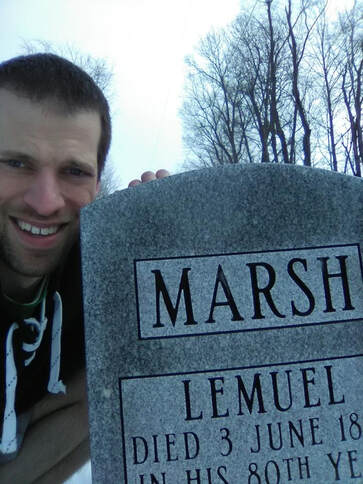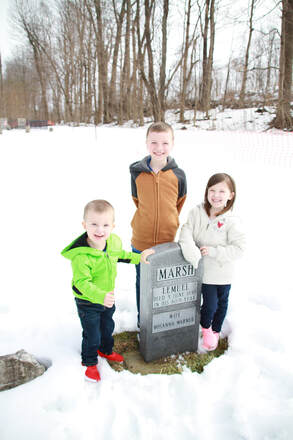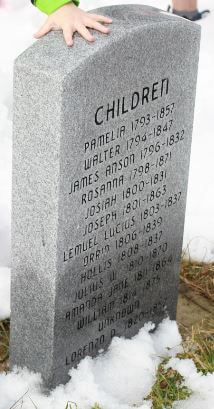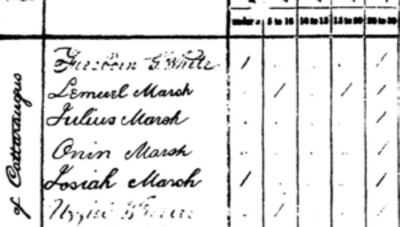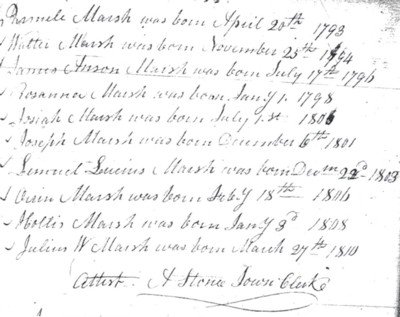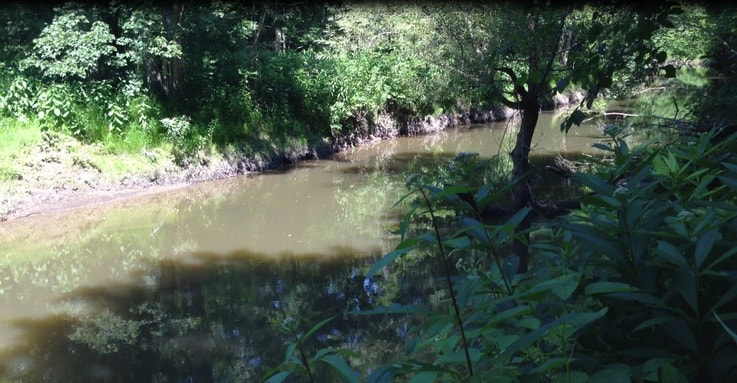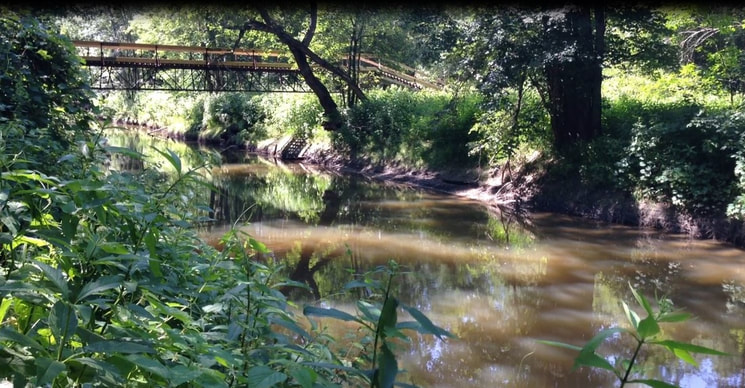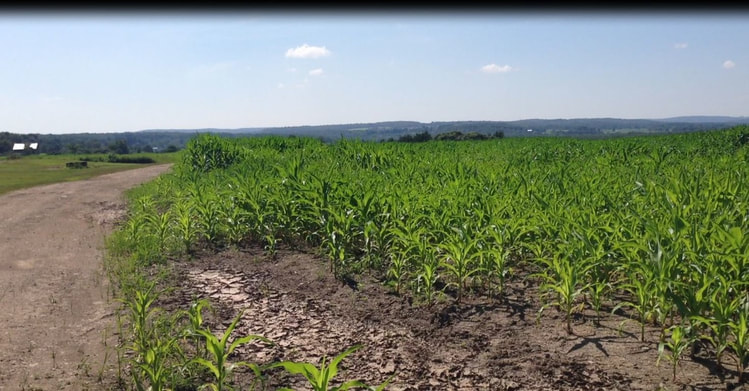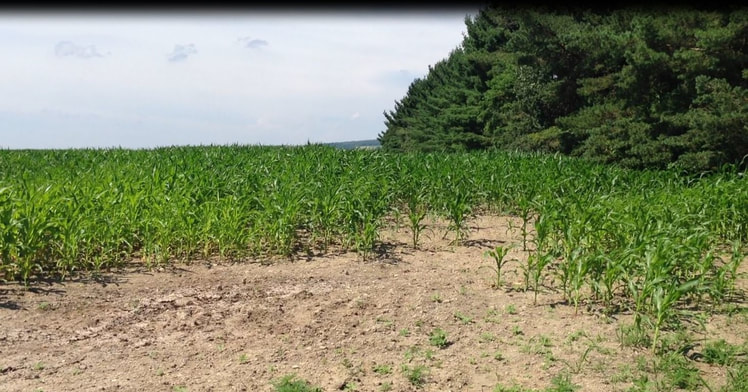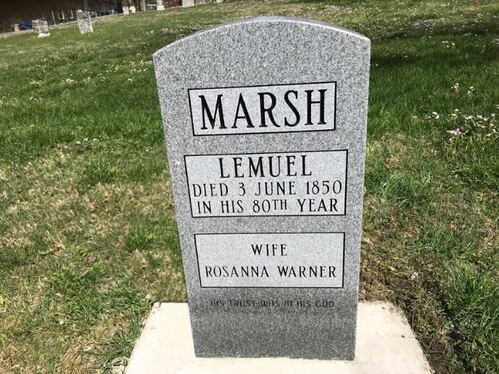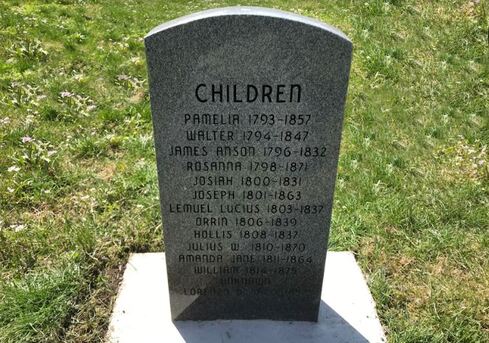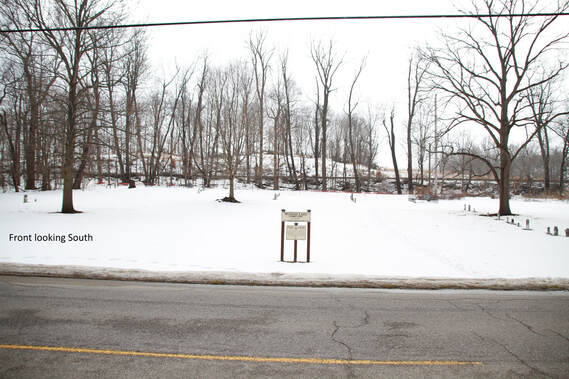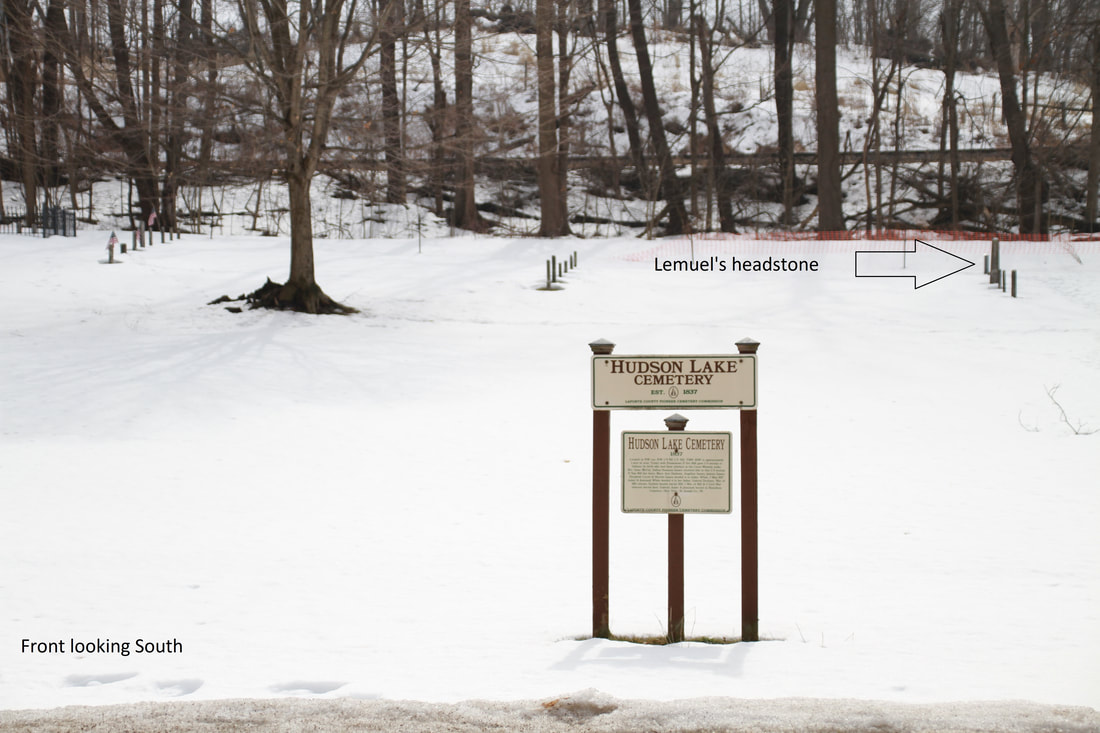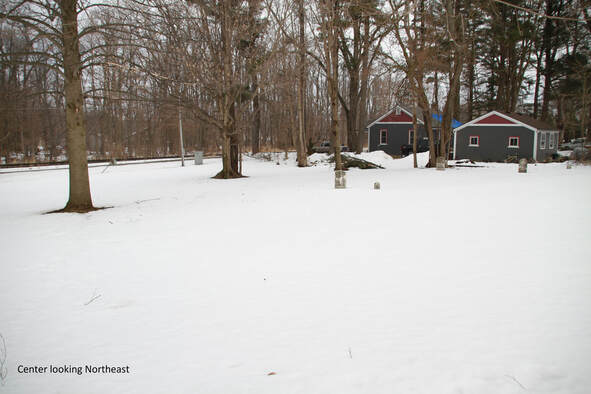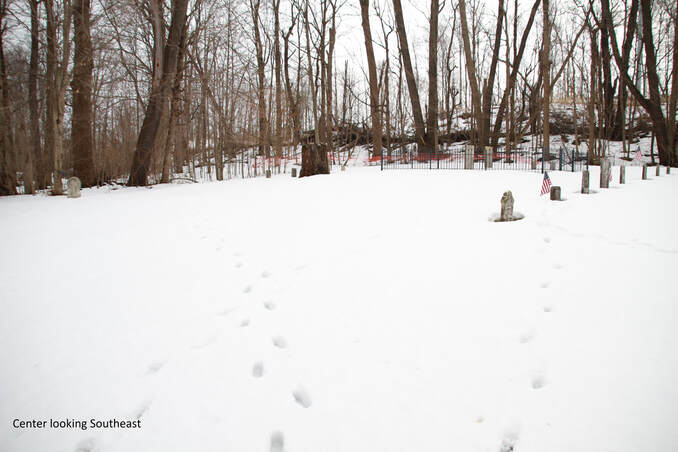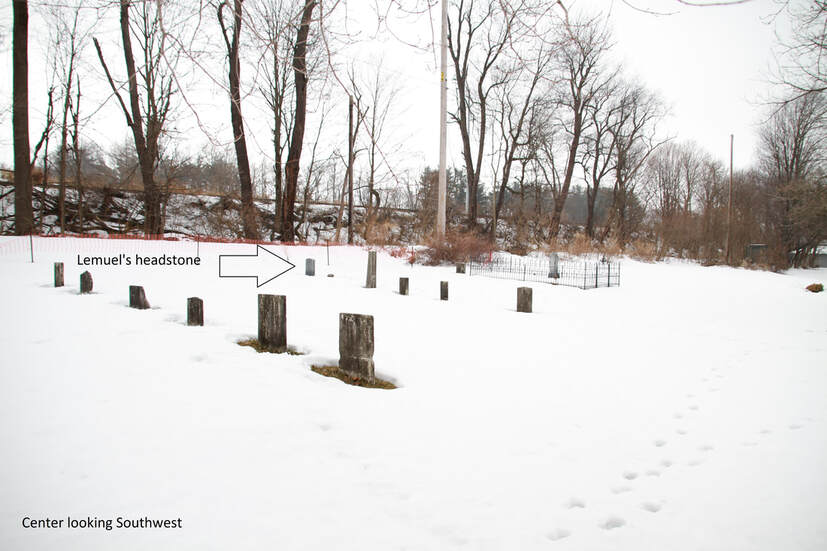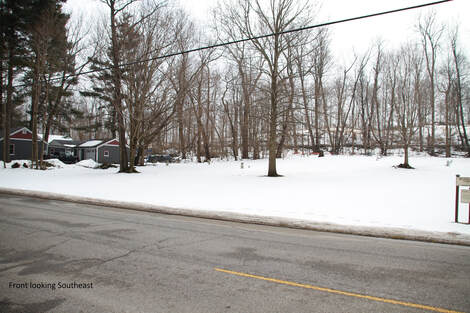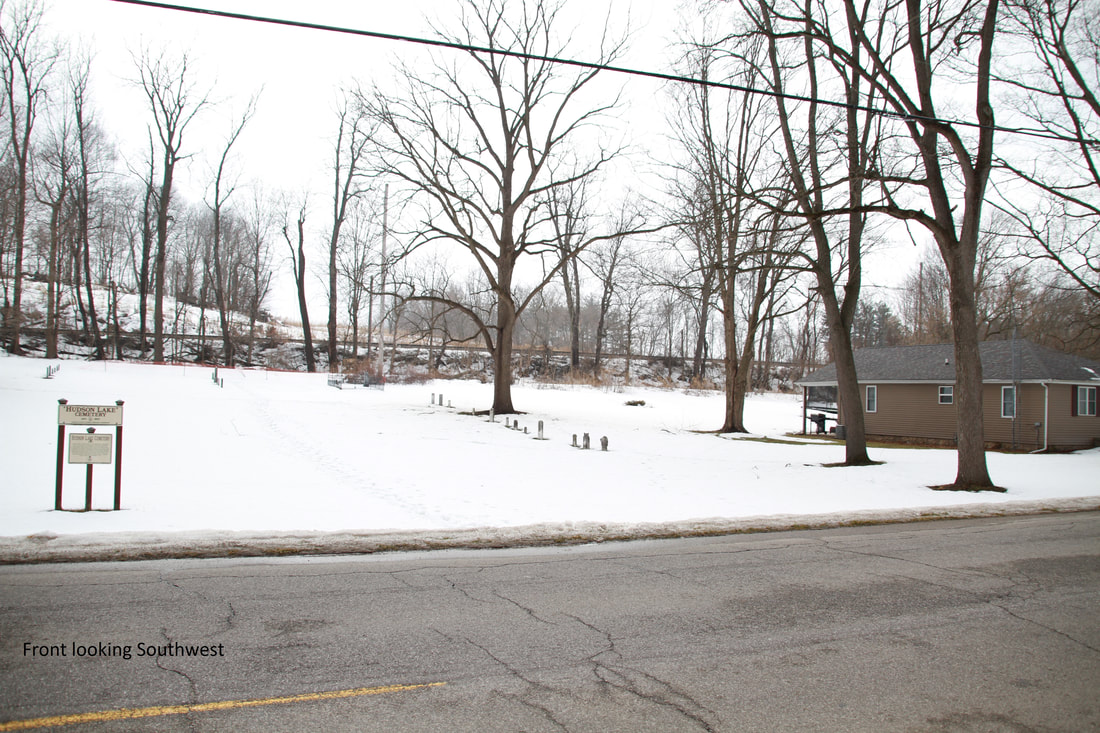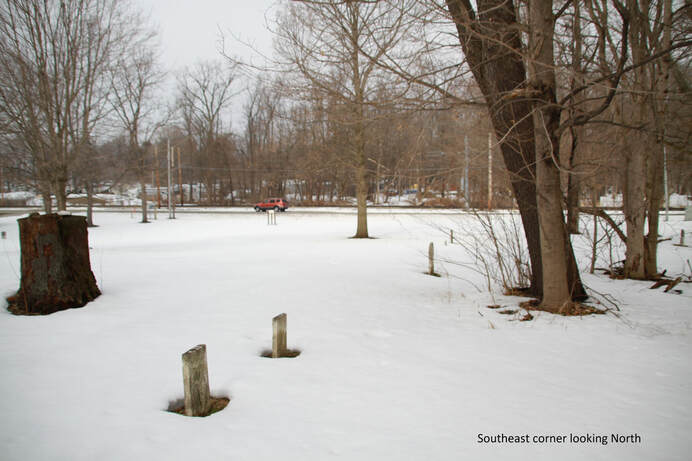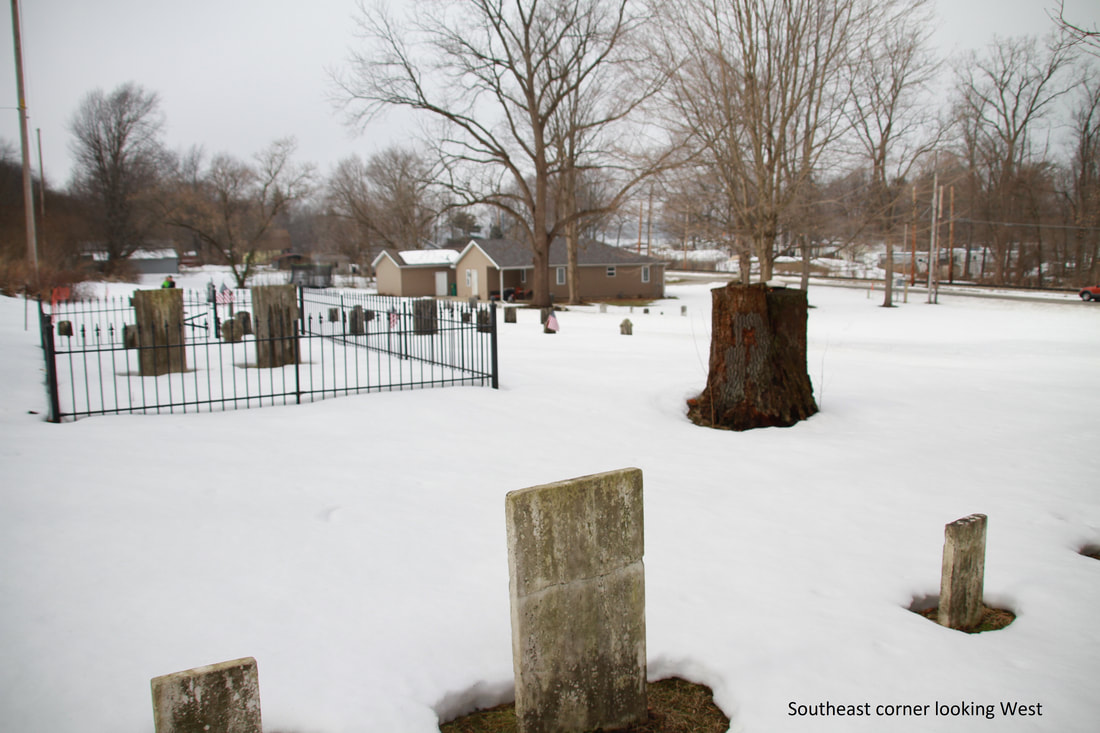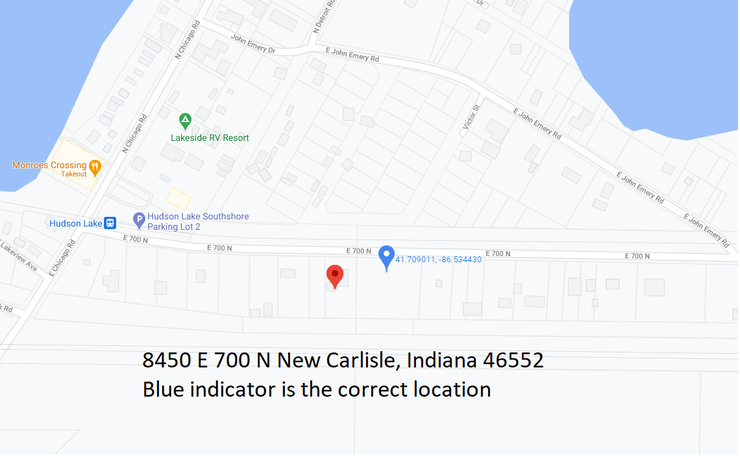His grandfather Lemuel Marsh and his grandmother Rosanna Warner
NO LONGER FORGOTTEN
How many sixth-great grandchildren do you think Lemuel and Rosanna have?
Photos special courtesy of Michael and Hailey Hepworth
Photos special courtesy of Michael and Hailey Hepworth
It is a good thing my 2nd g grandfather, George Josiah Marsh, took time to record a little of his life, or his ancestry would never have been found.
He wrote, “I was born in 1830, April 15. My place of birth was in the State of New York, Chautauqua [Cattaraugus] County, town of Randolph. My father, Josiah Marsh, belonged to the Bible Christian religion. He was married to my mother, Sally Powell, in 1826. Their first child was a girl, the only child they had except myself. My mother believed and worshiped with the Methodist persuasion. Differing in their religious views did not affect their happiness. They believed that if they were good moral people, they would be saved as well in one church as another.
“My father, about the time of my birth, met with an accident which caused his death. In cutting the lock of a hoop with a very sharp pointed knife, he let it slip into his leg just above the knee. He was laid up with it for some time, but being a man of great ambitions, he went to work before it was sound, which proved fatal to him and ended in his death. He died in 1831, leaving my mother with my sister Jane and myself.
“They had gathered together enough to purchase a farm and had begun to get things around them to make them quite independent. As soon as the death of my father was made public, the creditors gave my mother no peace. My mother finding her situation to be very unpleasant, being without anyone to manage her business, she got acquainted with a man by the name of Samuel Ferrin, who also had two children, a boy and a girl. Julia, the girl, was one year older than my sister, Jane, who was born in 1828 in June. His son, Jacob, was one month and a half younger than myself. My mother was advised to marry him, and after she had kept his company some time, she visited his father's family, and on her return she married him. They were married in 1833.”[i]
Efforts were made to tie George Josiah’s father, Josiah Marsh, as a son to the George Marsh shown in other research. There was never any evidence found of that connection.
The 1830 census was the starting point in the new research. Josiah Marsh was found in Cattaraugus County, but in the town of Conewango.[ii] George Josiah said he was born in Randolph. A town historian explained that Conewango and Randolph, Cattaraugus, New York, sit so closely that no one there really knows the boundary line. Josiah died shortly after the census was taken, but at least one of his neighbors listed in Conewango in 1830 was in the 1840 census in Randolph,[iii] which was officially formed from Conewango on Feb 1, 1826, but the boundaries changed over the years.[iv]
He wrote, “I was born in 1830, April 15. My place of birth was in the State of New York, Chautauqua [Cattaraugus] County, town of Randolph. My father, Josiah Marsh, belonged to the Bible Christian religion. He was married to my mother, Sally Powell, in 1826. Their first child was a girl, the only child they had except myself. My mother believed and worshiped with the Methodist persuasion. Differing in their religious views did not affect their happiness. They believed that if they were good moral people, they would be saved as well in one church as another.
“My father, about the time of my birth, met with an accident which caused his death. In cutting the lock of a hoop with a very sharp pointed knife, he let it slip into his leg just above the knee. He was laid up with it for some time, but being a man of great ambitions, he went to work before it was sound, which proved fatal to him and ended in his death. He died in 1831, leaving my mother with my sister Jane and myself.
“They had gathered together enough to purchase a farm and had begun to get things around them to make them quite independent. As soon as the death of my father was made public, the creditors gave my mother no peace. My mother finding her situation to be very unpleasant, being without anyone to manage her business, she got acquainted with a man by the name of Samuel Ferrin, who also had two children, a boy and a girl. Julia, the girl, was one year older than my sister, Jane, who was born in 1828 in June. His son, Jacob, was one month and a half younger than myself. My mother was advised to marry him, and after she had kept his company some time, she visited his father's family, and on her return she married him. They were married in 1833.”[i]
Efforts were made to tie George Josiah’s father, Josiah Marsh, as a son to the George Marsh shown in other research. There was never any evidence found of that connection.
The 1830 census was the starting point in the new research. Josiah Marsh was found in Cattaraugus County, but in the town of Conewango.[ii] George Josiah said he was born in Randolph. A town historian explained that Conewango and Randolph, Cattaraugus, New York, sit so closely that no one there really knows the boundary line. Josiah died shortly after the census was taken, but at least one of his neighbors listed in Conewango in 1830 was in the 1840 census in Randolph,[iii] which was officially formed from Conewango on Feb 1, 1826, but the boundaries changed over the years.[iv]
1830 census – Heritage Quest
There were other Marshes listed as neighbors. The names were interesting and uncommon, Lemuel Marsh, Julius Marsh, and Orrin Marsh, all living side by side of Josiah. Lemuel was the man old enough to be the father, and Josiah, Julius, and Orrin were brothers! Still, Lemuel could not be found in the 1820 U.S. census, and there was no idea where he was from. Years passed before a find was made in the Pedigree Resource File belonging to the Church of Jesus Christ of Latter-Day Saints. There was an Orrin Marsh born in St Albans, Franklin, Vermont, about the right time period. A Julius Marsh was found from the same town and time frame. For some reason, Josiah was left out of the index, but he was in the file. There were also other siblings shown, but there was no father or mother listed.
The record office of St. Albans sent records showing the first nine children of this family with no parents listed.[v] The History of Franklin and Grand Isle Counties also lists the first nine children of this family with no father listed,[vi] but the Vermont vitals completely missed the family.[vii]
There was only one Marsh man listed in the 1800 census in St. Albans, Vermont.[viii] There was only one Marsh man listed in a special tax list of the area for 1800.[ix] There was only one Marsh man listed in the town records of St. Albans from 1793 - 1803.[x] It is not surprising that his name was Lemuel Marsh. There was an Augustus Marsh and his wife, Hannah, (no apparent relation) that had a family in St. Albans beginning in 1803, but for each of their eight children, the parents were also listed.[xi] There were also seven different deeds on record where Lemuel bought and sold land in this area during the time these children were born. Their births were just recorded at the same time and without the names of their parents.
There was only one Marsh man listed in the 1800 census in St. Albans, Vermont.[viii] There was only one Marsh man listed in a special tax list of the area for 1800.[ix] There was only one Marsh man listed in the town records of St. Albans from 1793 - 1803.[x] It is not surprising that his name was Lemuel Marsh. There was an Augustus Marsh and his wife, Hannah, (no apparent relation) that had a family in St. Albans beginning in 1803, but for each of their eight children, the parents were also listed.[xi] There were also seven different deeds on record where Lemuel bought and sold land in this area during the time these children were born. Their births were just recorded at the same time and without the names of their parents.
- 17 July 1794. David Warner sold the south half of lot 84 to Lemuel Marsh.[xii]
- 29 December 1801. John Spencer sold fourteen acres of David's land to Lemuel Marsh (both men named as executors of David Warner's will) to raise money to pay debts owed from the estate.[xiii]
- 1 January 1807. David Powers sold the whole of lot 84 at public vendue to Lemuel Marsh, 30 Dec 1805, and he was now deeding him the land.[xiv]
- 24 June 1807. Lemuel Marsh gave Rebecca Warner a life lease on the fourteen acre piece he had purchased from David Warner.[xv]
- 27 June 1807. Lemuel Marsh quit claimed land on lot 84 to Moses Post (lower Cunadol) and John Spencer (Clarendon) according to the will of David Warner.[xvi]
- 9 March 1813. Lemuel Marsh mortgaged some land to N.W. Kingman.[xvii]
- 17 April 1817. Lemuel Marsh sold to Aaron Howard for $650 dollars the south half of lot 84, fourteen acres on the east end of the north half of the lot, and sixty-four acres on the west side of the road, which part was still encumbered by mortgage, and Aaron Howard was to pay what was owed.[xviii]
In the 1800 U.S. census of St. Albans, it said that Lemuel had five children under the age of ten, two boys and three girls. That was a census mistake according to Lemuel's recording of his children. It should have said three boys and two girls. Some census indexes have read the name "Lem Marsh" as "Lem Mank", and that is the way it was indexed in the 1810 census on Ancestry.com.[xix]
The town records turned up more information on him. The lists of members of the town in 1790, 1791, and 1792, did not show Lemuel or any other Marsh. There was no list of town members in 1793 or after, but his daughter's birth being recorded in the town records indicates he was there.
The town records turned up more information on him. The lists of members of the town in 1790, 1791, and 1792, did not show Lemuel or any other Marsh. There was no list of town members in 1793 or after, but his daughter's birth being recorded in the town records indicates he was there.
- He was listed on the grand tax list in 1799 having paid $51.25.
- On 3 Mar 1800, he was made a surveyor of highways.
- In 1800 he was also on the grand tax list having paid $72.50.
- In 1801 he paid $112.50 in taxes.
- In 1803 Lemuel was listed as an elector for a representative to Congress, and he was on the grand tax list.
- In 1804, Lemuel was again sworn to be a surveyor of highways and was assigned the "north middle". He was on the 1804 grand tax list for $95.00 and in 1806 for $95.00.
- Lemuel was a highway surveyor again in 1807, and he was on the tax list that year for $98.50.
- He had some responsibility in 1808 to count or report the scholars of his area in the 5th District that were of the age of four to eighteen years, and he reported that there were 60. He was voted to this position on the 30 Apr 1808. He was on the grand tax list for the amount of $95.00.
- In September of 1808, Lemuel was again an elector for a representative to Congress. He was elected to be a petit juror in 1809, and he reported 65 scholars in the 5th District in the same year. He paid $119.75 in taxes.
- He was a petit juror again in 1810, and he reported 57 scholars in his district in that year. He voted for a representative to the assembly, and he paid $106.50 in taxes.
- He paid $188.75 on the grand tax list for 1811; there were 38 scholars reported the same year.
- There were scholars mentioned for his district in 1812, but the trustees were not given. There was another reference to him being either a juror or a highway surveyor, but it was not clear which one. Lemuel voted as a freeman in 1812 and was a surveyor in 1813.
- For taxes in 1812, he paid $100.75, in 1813, it was $106.00, in 1814- $114.50, 1815- $136.75, 1816- $134.50, and in 1817, he paid $139.00. That was the end of the tax information that could be found.
- In 1814 Lemuel voted as a freeman, 1815 he voted for a town representative, in 1816 he was on the freeman's list as voting and also cast a ballot for a town rep.
- In 1816 Lemuel's son, Walter, was admitted and sworn as a freeman.
- In 1817 Lemuel was a surveyor of highways and voted, but after that there was no trace of him. There were some missing records through that time, but he did not pay any taxes in 1818 or 1819. It may have been a bit of a surprise that he was leaving town as he was elected to be a surveyor of highways in March of 1817, just a month before he sold his land.[xx]
It was later found that Lemuel had at least four sons who were editors and/or printers, and at least four who were preachers. That says something about Lemuel and Rosanna's interest in education and religion.
Joseph Marsh, Lemuel’s son, wrote about returning home to where he grew up in St. Albans.
"September 20, 1860. In company with my sister Bacon [Rosanna Marsh Bacon] and husband, I visited St. Albans, Vt., the place of my nativity, from which I had been absent forty-three years, as had also my sister; and as a matter of course, it and we had greatly changed. - While the hand of time had begun to furrow our cheeks and whiten our locks, the hand of art had pulled down the old house and barn and built new and better ones in a better place; had closed the old road and made one where it should be; had so drained the "ash swamp," and "cattail flag pasture," as to make them fertile fields, and dry up the babbling brook in which I used to wade, and the overflowed meadow where I used to slide and skate on the ice and fall and bruise my head, and make my nose bleed; it had stretched the railroad and telegraph line across the old "sugar bush," where I used to cool and chi(?) on a ball of snow maple sugar, and play and shout with youthful associates; it had turned swamps of cedar and dry lands into verdant meadows and fertile fields.
"With these changes of art I was well pleased, but some things which the cankering hand of time had done, I did not like so well. It had destroyed the magnificent balm of Gilead under whose cooling shade I have often played, and the large wild cherry trees which I loved to climb and eat the fruit which once very nearly terminated my life - it had so destroyed the old orchard, as to leave here and there a half withered tree, under one of which I have hid in the tall grass all day, rather than "go to school," and at night was tied by my thumbs to the chamber ladder for the offense. And worse than all, this enemy had scattered and slain kindred and youthful associates so that not one appeared as they did forty-three years ago! Only one of all my ‘play mates,’ could be found, and he was not the laughing, ‘Rat Jewett,’ but the gray headed Erastus Jewett, Esq.! Gladly would I have called back the scenes of my youth, but I could not; we therefore forever bade adieu to the scenes of our childhood, and met in the evening in the school house near where I was taught to read, and gave a discourse to an apparently deeply interested audience, on the glorious doctrine of the resurrection. Blessed theme! It inspires the glorious hope of soon meeting with all our Heavenly Father's family, not at the home of our childhood as it and we were then, but as each will be in the age to come - the world of glory."[xxi]
Every resource in the Vermont Research Guide[xxii] did not turn up Lemuel's father. There was an old sheet found that said an Amos Marsh had a son named Lemuel. The Clarendon record office said the town did not have a historical society, but I could contact a Dawn Hance there. She directed me to Amos' probate. "Set out and distributed to Lemuel Marsh the son of the deceased a piece of land beginning at the SW corner of the third and..." This also had Lemuel's actual signature, as after he was fourteen, he was able to choose his own guardian.[xxiii]
Lemuel's deeds gave the information as to who his wife must have been. Rosanna Warner Marsh's name was found in David Warner's probate, as well as Lemuel being an executor of his father-in-law's will.[xxiv] Dawn Hance’s knowledge that the David Warner and Amos Marsh farms sat together in Clarendon added to the evidence for the parents of both individuals.[xxv] Lemuel followed his school sweetheart when her father moved from Clarendon.
The Marsh family leaving Vermont so quickly was later understood by the fact that there was a terrible freeze there in 1816 that destroyed the crops.[xxvi] By the spring of 1817, prices were so high on everything that people could not even buy seed for their land. People left Vermont in large numbers, and Lemuel and many of his family went with them. That explains the "surveyor of highways" one month and selling his land the next. The move to New York left Lemuel's two married daughters, Pamelia Twitchell and Rosanna Bacon, behind in Vermont.[xxvii]
It was later found that Lemuel went to Bergen, Genesee, New York where he was found in the census of 1820 with his name written incorrectly as Lemuel Mash.[xxviii] Then it became apparent that Lemuel had more children than were recorded in St. Albans in 1810. The biography of Lemuel's granddaughter, “The Life and Work of Jane Marsh Parker" says that Jane's father and Lemuel's son, Joseph Marsh, was "the son of a Vermont pioneer in the Genesee Valley...one of sixteen children".[xxix] The census records have only indicated fourteen.
In 1820, Lemuel's son, Walter, was in the neighboring town of LeRoy with some cousins.[xxx] Neither he nor Lemuel were found in the land records of Genesee; perhaps they did not record their deeds or they did not purchase land there.
In 1824, Rosanna Warner Marsh passed away[xxxi], and death was a frequent visitor among the Marsh family during the next fifteen years. Lemuel and Rosanna’s son, Josiah, died in 1831, James A. died in 1832, Hollis' death came in 1837, Lemuel Lucius died sometime before October of that year, and Orrin’s death came in 1839. How Lemuel’s heart must have ached!
Lemuel married again in Bergen[xxxii], and moved, probably about 1826, to Randolph or Conewango, Cattaraugus, York, and in the 1830 census there was a new wife shown in his home and two teen-age stepdaughters.[xxxiii]
Joseph Marsh also wrote about visiting his father’s family in Randolph and printed this tender reflection from 16th of October, 1837, in his newspaper.
"In Randolph Cattaraugus Co., lived my aged father. I had not been at home for about eight years. Found my father, my step-mother, and the small remnant of the family that yet lives with them, blessed in health. But O! What changes have taken place in the family since I left home! My dear mother's place was now filled by one, who to me was almost an entire stranger. My much beloved brothers Josiah, Lemuel L. and Hollis, had fallen by death, and were quietly reposing side by side, in the lone graveyard not far distant. In would be in vain to attempt a description of my feelings on entering my long (?), absent (?) house where these things were all fresh before me, especially on visiting the grave yard where my brothers lay. ‘There’, said my trembling father, while tears trickled down his furrowed (?) cheeks, pointing to three little hillocks of earth, ‘lies three of your brothers’. He had depended first upon one, then upon the other, to sustain him in his old age; but death, in this respect, had blasted all his prospects. He was now bending under the infirmities of near seventy years, but his trust was in his God, and in the midst of all his grief, as his last, his only consolation, could look forward with a hope of immortality to the resurrection morn (?). Ah! Said he, they were good children, and thank God, they finished their course in the triumphs of faith. Yes, thank God, responded my throbbing heart, if faithful a few days more, I shall meet them, eternally blessed, beyond the confines of the tomb. In Randolph, there is no church of the Christian name, but an effectual door is opened for the reception of a free gospel."[xxxiv]
Lemuel gave right-of-way to the railroad in 1839.[xxxv]
In looking for men that could have been Lemuel's sons not recorded in the records of St. Albans, William Marsh was found in the 1850 Berrien, Michigan census, just the right age and born the right place to be a son, but the astonishing thing was finding Lemuel living with him!![xxxvi] Later, Amanda Jane Marsh White, Lemuel's daughter was found living right next door to William and Lemuel. More finds showed that William was living on farms in Berrien County, Michigan, and Hudson, LaPorte, Indiana, just a day's wagon drive between the two.
Joseph Marsh, Lemuel’s son, wrote about returning home to where he grew up in St. Albans.
"September 20, 1860. In company with my sister Bacon [Rosanna Marsh Bacon] and husband, I visited St. Albans, Vt., the place of my nativity, from which I had been absent forty-three years, as had also my sister; and as a matter of course, it and we had greatly changed. - While the hand of time had begun to furrow our cheeks and whiten our locks, the hand of art had pulled down the old house and barn and built new and better ones in a better place; had closed the old road and made one where it should be; had so drained the "ash swamp," and "cattail flag pasture," as to make them fertile fields, and dry up the babbling brook in which I used to wade, and the overflowed meadow where I used to slide and skate on the ice and fall and bruise my head, and make my nose bleed; it had stretched the railroad and telegraph line across the old "sugar bush," where I used to cool and chi(?) on a ball of snow maple sugar, and play and shout with youthful associates; it had turned swamps of cedar and dry lands into verdant meadows and fertile fields.
"With these changes of art I was well pleased, but some things which the cankering hand of time had done, I did not like so well. It had destroyed the magnificent balm of Gilead under whose cooling shade I have often played, and the large wild cherry trees which I loved to climb and eat the fruit which once very nearly terminated my life - it had so destroyed the old orchard, as to leave here and there a half withered tree, under one of which I have hid in the tall grass all day, rather than "go to school," and at night was tied by my thumbs to the chamber ladder for the offense. And worse than all, this enemy had scattered and slain kindred and youthful associates so that not one appeared as they did forty-three years ago! Only one of all my ‘play mates,’ could be found, and he was not the laughing, ‘Rat Jewett,’ but the gray headed Erastus Jewett, Esq.! Gladly would I have called back the scenes of my youth, but I could not; we therefore forever bade adieu to the scenes of our childhood, and met in the evening in the school house near where I was taught to read, and gave a discourse to an apparently deeply interested audience, on the glorious doctrine of the resurrection. Blessed theme! It inspires the glorious hope of soon meeting with all our Heavenly Father's family, not at the home of our childhood as it and we were then, but as each will be in the age to come - the world of glory."[xxi]
Every resource in the Vermont Research Guide[xxii] did not turn up Lemuel's father. There was an old sheet found that said an Amos Marsh had a son named Lemuel. The Clarendon record office said the town did not have a historical society, but I could contact a Dawn Hance there. She directed me to Amos' probate. "Set out and distributed to Lemuel Marsh the son of the deceased a piece of land beginning at the SW corner of the third and..." This also had Lemuel's actual signature, as after he was fourteen, he was able to choose his own guardian.[xxiii]
Lemuel's deeds gave the information as to who his wife must have been. Rosanna Warner Marsh's name was found in David Warner's probate, as well as Lemuel being an executor of his father-in-law's will.[xxiv] Dawn Hance’s knowledge that the David Warner and Amos Marsh farms sat together in Clarendon added to the evidence for the parents of both individuals.[xxv] Lemuel followed his school sweetheart when her father moved from Clarendon.
The Marsh family leaving Vermont so quickly was later understood by the fact that there was a terrible freeze there in 1816 that destroyed the crops.[xxvi] By the spring of 1817, prices were so high on everything that people could not even buy seed for their land. People left Vermont in large numbers, and Lemuel and many of his family went with them. That explains the "surveyor of highways" one month and selling his land the next. The move to New York left Lemuel's two married daughters, Pamelia Twitchell and Rosanna Bacon, behind in Vermont.[xxvii]
It was later found that Lemuel went to Bergen, Genesee, New York where he was found in the census of 1820 with his name written incorrectly as Lemuel Mash.[xxviii] Then it became apparent that Lemuel had more children than were recorded in St. Albans in 1810. The biography of Lemuel's granddaughter, “The Life and Work of Jane Marsh Parker" says that Jane's father and Lemuel's son, Joseph Marsh, was "the son of a Vermont pioneer in the Genesee Valley...one of sixteen children".[xxix] The census records have only indicated fourteen.
In 1820, Lemuel's son, Walter, was in the neighboring town of LeRoy with some cousins.[xxx] Neither he nor Lemuel were found in the land records of Genesee; perhaps they did not record their deeds or they did not purchase land there.
In 1824, Rosanna Warner Marsh passed away[xxxi], and death was a frequent visitor among the Marsh family during the next fifteen years. Lemuel and Rosanna’s son, Josiah, died in 1831, James A. died in 1832, Hollis' death came in 1837, Lemuel Lucius died sometime before October of that year, and Orrin’s death came in 1839. How Lemuel’s heart must have ached!
Lemuel married again in Bergen[xxxii], and moved, probably about 1826, to Randolph or Conewango, Cattaraugus, York, and in the 1830 census there was a new wife shown in his home and two teen-age stepdaughters.[xxxiii]
Joseph Marsh also wrote about visiting his father’s family in Randolph and printed this tender reflection from 16th of October, 1837, in his newspaper.
"In Randolph Cattaraugus Co., lived my aged father. I had not been at home for about eight years. Found my father, my step-mother, and the small remnant of the family that yet lives with them, blessed in health. But O! What changes have taken place in the family since I left home! My dear mother's place was now filled by one, who to me was almost an entire stranger. My much beloved brothers Josiah, Lemuel L. and Hollis, had fallen by death, and were quietly reposing side by side, in the lone graveyard not far distant. In would be in vain to attempt a description of my feelings on entering my long (?), absent (?) house where these things were all fresh before me, especially on visiting the grave yard where my brothers lay. ‘There’, said my trembling father, while tears trickled down his furrowed (?) cheeks, pointing to three little hillocks of earth, ‘lies three of your brothers’. He had depended first upon one, then upon the other, to sustain him in his old age; but death, in this respect, had blasted all his prospects. He was now bending under the infirmities of near seventy years, but his trust was in his God, and in the midst of all his grief, as his last, his only consolation, could look forward with a hope of immortality to the resurrection morn (?). Ah! Said he, they were good children, and thank God, they finished their course in the triumphs of faith. Yes, thank God, responded my throbbing heart, if faithful a few days more, I shall meet them, eternally blessed, beyond the confines of the tomb. In Randolph, there is no church of the Christian name, but an effectual door is opened for the reception of a free gospel."[xxxiv]
Lemuel gave right-of-way to the railroad in 1839.[xxxv]
In looking for men that could have been Lemuel's sons not recorded in the records of St. Albans, William Marsh was found in the 1850 Berrien, Michigan census, just the right age and born the right place to be a son, but the astonishing thing was finding Lemuel living with him!![xxxvi] Later, Amanda Jane Marsh White, Lemuel's daughter was found living right next door to William and Lemuel. More finds showed that William was living on farms in Berrien County, Michigan, and Hudson, LaPorte, Indiana, just a day's wagon drive between the two.
Conewango Creek north of Lemuel’s land in Cattaraugus County, New York
Photos special courtesy of Scott C. Marsh
Photos special courtesy of Scott C. Marsh
This is thought to be Lemuel’s land looking west and then towards the north.
It was probably heavily timbered in Lemuel’s day.
Photos special courtesy of Scott C. Marsh
Thanks to Bob Matson for helping locate the land.
It was probably heavily timbered in Lemuel’s day.
Photos special courtesy of Scott C. Marsh
Thanks to Bob Matson for helping locate the land.
While still only a theory that came late in the research, I think Lemuel married (2) Roxanna Chapin, the widow of Nathaniel Barmore, and mother of Roxanna Barmore who married Lemuel’s son, William. Listed here are the evidences:
- The Barmores and the Marshes would have known each other from Bergen, Genesee, New York.
- Nathaniel Barmore died in 1821 in Bergen, about the same time that Rosanna Marsh died, also in Bergen.
- Roxanna Chapin Barmore was born in 1782, and was the right age to be Lemuel's wife from the 1830 and 1840 census years. From the census work done on her children by William Utermohlen, Roxana was not living in the home of any of her children in the 1830 and 1840 census years, which points to a second marriage.
- Roxanna's two youngest daughters were the only ones of the Barmore children that were not married by 1830, and the only ones that Roxanna would have still had with her. They were also the right age to be the teenage stepdaughters of Lemuel Marsh from the 1830 census.
- The Barmore's four youngest children all married in Cattaraugus County, starting in 1827. It would seem that their mother must have married someone whose move would take her and her family to Cattaraugus; it is doubtful she would have moved on her own. Lemuel was likely in Cattaraugus by about 1826, because of his son, Josiah, marrying Sally Clotilda Powell about that time.
- William Marsh married the Barmore's daughter, Roxanna Barmore. They could have shared several years in the same home before their marriage. It may also be an indicator that Lemuel Marsh was living in the William Marsh home (1850 census) rather than the Amanda Jane Marsh White home (next door to William) as William and Roxanna would have been caring for both William's father and Roxanna's mother. Had it previously just been Lemuel, he would have likely been in the home of his daughter.
- Adna Barmore, Roxana's son, was living next door to the Marshes in the 1840 census. His mother living in Lemuel's home makes that more probable.
- At least six of the Barmore siblings wound up in Berrien County, Michigan, and LaPorte County, Indiana, living very near to William and Roxanna Marsh (with Lemuel in their home in 1850) and Freeborn and Amanda Jane Marsh White. Roxanna Chapin Barmore (Marsh?) may have started on the trip with them to that area, and died before the 1850 census. Barmore family records show that Roxana died in 1857 (place unknown), but she has not been located in the 1850 census.
Jane Marsh Parker of Rochester, New York wrote to her cousin, Hollis Marsh Jr. of Randolph, for genealogy information, and this is the letter she received.
“So you will see that I ought to know something about it. Unkle Josiah and another unkle died several years previous, I think his name was Joseph, to my father's death. They are all buried side by side in the Cemetery here on a lot which I now own. Granfather, Granmother, Unkle William, Unkle Julius & their families moved from here to Michigan when I was about eight or nine years old. At that time, I lived with my Mother and StepFather acrost the road from them. I have not heard from them since but once, that was about 2 years ago I received a letter from Unkle Julius which I answered, have not heard from them since. Granfather and Granmother were both dead then. Please write to me & let me know which one of my Unkles was your Father, & do you know any thing of the former history of Granfather. Where he moved from when he came here. I have wanted for a long time to learn something of my ancesters. Hoping to hear from you soon I subscribe my name as your Cousin Hollis Marsh, NY."[xxxvii]
“So you will see that I ought to know something about it. Unkle Josiah and another unkle died several years previous, I think his name was Joseph, to my father's death. They are all buried side by side in the Cemetery here on a lot which I now own. Granfather, Granmother, Unkle William, Unkle Julius & their families moved from here to Michigan when I was about eight or nine years old. At that time, I lived with my Mother and StepFather acrost the road from them. I have not heard from them since but once, that was about 2 years ago I received a letter from Unkle Julius which I answered, have not heard from them since. Granfather and Granmother were both dead then. Please write to me & let me know which one of my Unkles was your Father, & do you know any thing of the former history of Granfather. Where he moved from when he came here. I have wanted for a long time to learn something of my ancesters. Hoping to hear from you soon I subscribe my name as your Cousin Hollis Marsh, NY."[xxxvii]
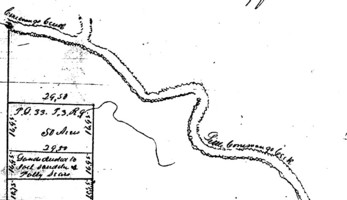
This map is from deeds and shows the confluence of Conewango Creek and Little Conewango Creeks and lot 33 in two pieces. [xxxviii]
The lot sits below the confluence of the rivers described in the history for Hollis Jr., Lemuel’s grandson, who said his grandfather had settled below the forks.[xxxix] Whether the deed for this land is one that burned in the Cattaraugus land record office fire,[xl] or whether it was never recorded is not known, but there is no record in Cattaraugus County for Josiah's, Hollis', Orrin's, Julius', William's or Lemuel's purchase or sale of land, except in the case of William selling part of lot 33 to Nathan and Polly Sears (Polly being Hollis’ widow) at the end of 1843 before leaving for Michigan with Lemuel in his wagon.[xli] William also mortgaged “a part” of lot 33 in 1839.[xlii] This land is also where Lemuel gave right-of-way to the railroad. These things indicate that Lemuel owned the top part of this lot.
The land Hollis deeded to his wife, Polly, from his will forms the southern boundary of “part of lot 33”.[xliii] Nathan Sears sold the part he purchased from William and moved on,[xliv] but Hollis' son, Hollis Jr., stayed in Randolph for years and mortgaged the property he received from his father's will several times. There are documents showing this map, and surely it is because part of the lot was tied up in probate for over 21 years waiting for Hollis Jr. to grow old enough to inherit it.
Thanks to Dana Palmer for the reference that Josiah Marsh purchased land from the Holland Land Company. The subsequent research gave more information on the land.
On April 19, 1824, Lemuel's son, Josiah Marsh, went to the Holland Land Company Office and purchased 405 acres of land, listed as lot 33, which was the same lot number of the Marshes in Randolph or Conewango, New York, depending on the boundaries of the town at any given year. Josiah paid only $38.00 of the $911.25 that was owed, leaving a balance of $873.25. Lemuel, may have provided part of this money and so owned some of the land. The entry of Josiah's name in the record, like all the rest of the names, was in the column of "Names of Debtors." This was not uncommon among the settles in the area; in fact, very few people had any credible amount of money to make a down payment with. Deeds were not given to a person in this situation, but the Holland Land Company retained the ownership of the property. There isn't any entry in the records showing that Josiah returned to the office to make payment on the land. This was also true of many of the settlers.
The 1830 census of Conewango, New York, shows Josiah living side-by-side of his father, Lemuel, and his brothers, Julius and Orrin. While Josiah's payment could have been intended to buy land for the family, neither Julius nor Orrin were old enough to own land in 1824, and Julius was not old enough to own land in 1830. The individuals in the Marsh family listed in Conewango in the 1830 census may have all been living on Josiah's land.
Then in 1831, Josiah contracted blood poisoning from a work related accident and died, still owing the balance on the land he began with.
On June 9, 1835, Josiah's brother, Hollis Marsh, is listed in the Holland Land Company "Modified Sales Record" as having purchased on lot 33, 100 acres, for $235.75. This is about 1/4 of what Josiah originally purchased. The explanation about a modified sale meant that the land had reverted to the Holland Land Company from lack of payment, which is another thing that happened to many of the settlers. It seems Hollis was trying to retain what land he could for himself and his family by purchasing some of what Josiah set out to do. Hollis' purchase was complete, and he would have been given a deed.
But then Hollis died of pneumonia in May of 1837 after writing into his will that his unborn child would inherit part of lot 33. Hollis' brother, William, later sold the other part of lot 33 to Nathan Sears, the new husband of Hollis' widow, just before William left for Michigan with Lemuel in his wagon. This sale, along with Lemuel's giving right-of-way to the railroad in 1839, indicates that he owned half of Hollis' purchase.
After finding that Lemuel's son, Joseph, was an early leader in the Millerite movement, it would be interesting to know if the sale of land in Cattaraugus had anything to do with it. Joseph would have communicated with his family about his belief. Did they and the Barmores believe it also?
Joseph wrote in his newspaper, 22 Oct 1844. “The Camp meeting (Millerites) noticed in our first number, to commence the first Wednesday in September, (Sept 4th, 1844), will be held at Bucklan’s Corner, town of Gerry, Chautauqua Co., NY instead of Buckey’s Corner as before published. By divine permission, the editor will attend this meeting. We shall leave home on Wednesday, the day the meeting commences; the same day take the evening boat for Dankirk, at which place we shall be glad to meet a friendly conveyance to the Camp ground. “I also solicit my father and relatives at Randolph, to attend this meeting, as I shall not be able to meet them at their homes.”[xlv]
Joseph also wrote this obituary of his father and printed it in his newspaper:
Marsh, Joseph, "Obituary of Lemuel Marsh" Advent Harbinger and Bible Advocate Vol.2:341 July 6, 1850. Used with permission of Atlanta Bible College Archives, McDonough, Ga.
"Lemuel Marsh - Father of the editor, died at Hudson, LaPorte, Indiana 3 June 1850, in the 80th year of his age.
“He spent the early part of his active life in St. Alban's, Franklin Co., Vermont, his native State, where he professed faith in Christ, and united with the Methodist Episcopal Church.
“In A.D. 1817, he moved to LeRoy, Genesee, New York, where, on account of denying the trinity and believing in the Unity of God, and that Christ is the Son of God, he was turned out of the M.E. Church. My mother and one or two brothers were turned out of the same church about that time, for the same cause.
“In LeRoy he buried his first wife, my pious mother, and soon after marrying his second wife, moved to Randolph, Cattaraugus, N.Y., where he buried three sons, my dear brothers, who died happily in the Lord.
“After spending several years of deprivation and incessant toil in the wilds(?) of Randolph, he moved to Hudson, Indiana, to fill up the measure of his days in that new and fertile country. There he paid the debt of nature, there he now (?), sleeps in death - (?) we trust, to awake to (?), and have a glorious part in the first resurrection.
“Blessed be the Lord!"[xlvi] (Last sentence illegible.)
Lemuel outlived at least six of his children, none of which died young, and he may have outlived three others. Two died within the next decade.
[xlvii]
The lot sits below the confluence of the rivers described in the history for Hollis Jr., Lemuel’s grandson, who said his grandfather had settled below the forks.[xxxix] Whether the deed for this land is one that burned in the Cattaraugus land record office fire,[xl] or whether it was never recorded is not known, but there is no record in Cattaraugus County for Josiah's, Hollis', Orrin's, Julius', William's or Lemuel's purchase or sale of land, except in the case of William selling part of lot 33 to Nathan and Polly Sears (Polly being Hollis’ widow) at the end of 1843 before leaving for Michigan with Lemuel in his wagon.[xli] William also mortgaged “a part” of lot 33 in 1839.[xlii] This land is also where Lemuel gave right-of-way to the railroad. These things indicate that Lemuel owned the top part of this lot.
The land Hollis deeded to his wife, Polly, from his will forms the southern boundary of “part of lot 33”.[xliii] Nathan Sears sold the part he purchased from William and moved on,[xliv] but Hollis' son, Hollis Jr., stayed in Randolph for years and mortgaged the property he received from his father's will several times. There are documents showing this map, and surely it is because part of the lot was tied up in probate for over 21 years waiting for Hollis Jr. to grow old enough to inherit it.
Thanks to Dana Palmer for the reference that Josiah Marsh purchased land from the Holland Land Company. The subsequent research gave more information on the land.
On April 19, 1824, Lemuel's son, Josiah Marsh, went to the Holland Land Company Office and purchased 405 acres of land, listed as lot 33, which was the same lot number of the Marshes in Randolph or Conewango, New York, depending on the boundaries of the town at any given year. Josiah paid only $38.00 of the $911.25 that was owed, leaving a balance of $873.25. Lemuel, may have provided part of this money and so owned some of the land. The entry of Josiah's name in the record, like all the rest of the names, was in the column of "Names of Debtors." This was not uncommon among the settles in the area; in fact, very few people had any credible amount of money to make a down payment with. Deeds were not given to a person in this situation, but the Holland Land Company retained the ownership of the property. There isn't any entry in the records showing that Josiah returned to the office to make payment on the land. This was also true of many of the settlers.
The 1830 census of Conewango, New York, shows Josiah living side-by-side of his father, Lemuel, and his brothers, Julius and Orrin. While Josiah's payment could have been intended to buy land for the family, neither Julius nor Orrin were old enough to own land in 1824, and Julius was not old enough to own land in 1830. The individuals in the Marsh family listed in Conewango in the 1830 census may have all been living on Josiah's land.
Then in 1831, Josiah contracted blood poisoning from a work related accident and died, still owing the balance on the land he began with.
On June 9, 1835, Josiah's brother, Hollis Marsh, is listed in the Holland Land Company "Modified Sales Record" as having purchased on lot 33, 100 acres, for $235.75. This is about 1/4 of what Josiah originally purchased. The explanation about a modified sale meant that the land had reverted to the Holland Land Company from lack of payment, which is another thing that happened to many of the settlers. It seems Hollis was trying to retain what land he could for himself and his family by purchasing some of what Josiah set out to do. Hollis' purchase was complete, and he would have been given a deed.
But then Hollis died of pneumonia in May of 1837 after writing into his will that his unborn child would inherit part of lot 33. Hollis' brother, William, later sold the other part of lot 33 to Nathan Sears, the new husband of Hollis' widow, just before William left for Michigan with Lemuel in his wagon. This sale, along with Lemuel's giving right-of-way to the railroad in 1839, indicates that he owned half of Hollis' purchase.
After finding that Lemuel's son, Joseph, was an early leader in the Millerite movement, it would be interesting to know if the sale of land in Cattaraugus had anything to do with it. Joseph would have communicated with his family about his belief. Did they and the Barmores believe it also?
Joseph wrote in his newspaper, 22 Oct 1844. “The Camp meeting (Millerites) noticed in our first number, to commence the first Wednesday in September, (Sept 4th, 1844), will be held at Bucklan’s Corner, town of Gerry, Chautauqua Co., NY instead of Buckey’s Corner as before published. By divine permission, the editor will attend this meeting. We shall leave home on Wednesday, the day the meeting commences; the same day take the evening boat for Dankirk, at which place we shall be glad to meet a friendly conveyance to the Camp ground. “I also solicit my father and relatives at Randolph, to attend this meeting, as I shall not be able to meet them at their homes.”[xlv]
Joseph also wrote this obituary of his father and printed it in his newspaper:
Marsh, Joseph, "Obituary of Lemuel Marsh" Advent Harbinger and Bible Advocate Vol.2:341 July 6, 1850. Used with permission of Atlanta Bible College Archives, McDonough, Ga.
"Lemuel Marsh - Father of the editor, died at Hudson, LaPorte, Indiana 3 June 1850, in the 80th year of his age.
“He spent the early part of his active life in St. Alban's, Franklin Co., Vermont, his native State, where he professed faith in Christ, and united with the Methodist Episcopal Church.
“In A.D. 1817, he moved to LeRoy, Genesee, New York, where, on account of denying the trinity and believing in the Unity of God, and that Christ is the Son of God, he was turned out of the M.E. Church. My mother and one or two brothers were turned out of the same church about that time, for the same cause.
“In LeRoy he buried his first wife, my pious mother, and soon after marrying his second wife, moved to Randolph, Cattaraugus, N.Y., where he buried three sons, my dear brothers, who died happily in the Lord.
“After spending several years of deprivation and incessant toil in the wilds(?) of Randolph, he moved to Hudson, Indiana, to fill up the measure of his days in that new and fertile country. There he paid the debt of nature, there he now (?), sleeps in death - (?) we trust, to awake to (?), and have a glorious part in the first resurrection.
“Blessed be the Lord!"[xlvi] (Last sentence illegible.)
Lemuel outlived at least six of his children, none of which died young, and he may have outlived three others. Two died within the next decade.
[xlvii]
With love and gratitude to Scott C. and Mary B. Marsh
for this stone to honor Lemuel's grave.
for this stone to honor Lemuel's grave.
The exact location of Lemuel's grave in the cemetery is not known, but this stone has now been placed to honor his memory.
The photos above were taken by the company that placed the stone.
The place of Rosanna's burial is still unknown.
Hudson Lake Cemetery
The photos above were taken by the company that placed the stone.
The place of Rosanna's burial is still unknown.
Hudson Lake Cemetery
Photos and directions special courtesy of Michael and Hailey Hepworth
IF YOU TRAVEL TO HUDSON LAKE CEMETERY, THE WEB WILL DIRECT YOU TO ROLLING PRAIRIE CEMETERY.
USE THIS INSTEAD -
IF YOU TRAVEL TO HUDSON LAKE CEMETERY, THE WEB WILL DIRECT YOU TO ROLLING PRAIRIE CEMETERY.
USE THIS INSTEAD -
[i] Marsh, George Josiah journal and record, #MS 1821, Church History Library, history.lds.org, Church of Jesus Christ
of Latter-Day Saints.
[ii] 1830 U.S. census, Conewango, Cattaraugus, New York, Josiah Marsh.
[iii] 1840 U.S. census, Randolph, Cattaraugus, New York.
[iv] US Genweb, Conewango, Cattaraugus, New York.
[v] Correspondence with St. Albans record office, P.O. Box 867, St. Albans, Vermont, 05478-0867.
[vi] Aldrich, Lewis Cass, ed., History of Franklin and Grand Isle Counties, Syracuse, N.Y., (D. Mason and Co., 1891),
FHL #974.31 H29.
[vii] Vermont Vitals can now be viewed on-line over FamilySearch.org.
[viii] 1800 U.S. census, St. Albans, Franklin, Vermont; the name Lemuel was indexed as Samuel on Ancestry.
[ix] St. Albans town records, FHL #0028859.
[x] Ibid.
[xi] Correspondence with St. Alban’s record office, P.O. Box 867, St. Albans, Vermont, 05478-0867.
[xii] St. Albans, Franklin, Vermont deed records, FHL #028, 860, pg. 100, 17 Jul 1794. Note the county is given as
Chittenden in the deed.
[xiii] St. Albans Old Village Records, vol. 2 pg. 169, correspondence with Richard J. Peters, assistant clerk, St. Albans.
[xiv] St. Albans Old Village Records, vol. 4 pg. 58, correspondence with Richard J. Peters, assistant clerk, St. Albans.
[xv] St. Albans Old Village Records, vol. 4 pg. 59, correspondence with Richard J. Peters, assistant clerk, St. Albans.
[xvi] St. Albans Old Village Records, vol. 4 pg. 60, correspondence with Richard J. Peters, assistant clerk, St. Albans.
[xvii] St. Albans Old Village Records, vol. 5 pg. 613, correspondence with Richard J. Peters, assistant clerk, St. Albans.
[xviii] St. Albans Old Village Records, vol. 6 pg. 476, correspondence with Richard J. Peters, assistant clerk, St. Albans.
[xix] 1800 U.S. census, Ancestry.com.
[xx] St. Albans town records FHL #0028859.
[xxi] Marsh, Joseph, Millennial Harbinger and Bible Expositor, courtesy of David R. Graham.
[xxii] The Vermont Resource Guide, The Church of Jesus Christ of Latter-Day Saints, now on FamilySearch.org.
[xxiii] Dawn D. Hance research files; Amos Marsh probate #79, Rutland Co., Probate Office, 83 Center Street, Rutland,
Vermont, 05701. (802)- 775-0114.
[xxiv] Franklin County, Vermont, probate records for David Warner, FHL #028,197 p. 83-84.
[xxv] Dawn D. Hance, see hand drawn map of the Marsh and Warner lots in Clarendon in the section for Amos Marsh.
[xxvi] “Virtual Vermont Internet Magazine”, “The Summer (?) of 1816”.
[xxvii] 1820-1850 (Twitchell) and 1820 – 1870 (Bacon) U.S. census years.
[xxviii] 1820 U.S. census, Lemuel Mash in Bergen, Genesee, New York.
[xxix] Lane, Marcelle LeMenager, “The Life and Work of Jane Marsh Parker”, Rochester Historical Society.
[xxx] 1820 U.S. census, LeRoy, Genesee, New York, Walter Marsh.
[xxxi] Parker, Jane Marsh, “History of Joseph Marsh”, on file with the author, courtesy of Sheron Long; the other
deaths in Lemuel’s family are all cited in the section for each child named in the paragraph.
[xxxii] Marsh, Joseph, “Obituary of Lemuel Marsh”, Advent Harbinger and Bible Advocate Vol. 2:341, July 6, 1850.
Courtesy of Jan Stilson, Church of God Historian. Used with permission of Atlanta Bible College Archives,
McDonough, Ga.
[xxxiii] 1830 U.S. census, Conewango, Cattaraugus, New York, Lemuel Marsh.
[xxxiv] Marsh, Joseph, Christian Palladium, 16th of October, 1837, courtesy of David R. Graham.
[xxxv] Miscellaneous records of Cattaraugus County, FHL #0583803.
[xxxvi] 1850 U.S. census, Berrien, Michigan, William Marsh. Note that Ancestry has indexed the name Lemuel as
Samuel, although the “Lemmul” name looks clearly different from the Samuel Gasset living next door.
[xxxvii] Courtesy of Sheron Long. Correspondence on file with the author.
[xxxviii] Cattaraugus County, New York mortgages, 1840-1842 vol. 6-7, FHL #583,798 Bk. 6 pg. 315.
[xxxix] See history in section for Lemuel’s son, Hollis Sr.
[xl] US Genweb Cattaraugus County.
[xli] Cattaraugus County, New York deeds, William Marsh and wife to Nathan and Polly Sears, 1843; deeds 1842-1848
vol. 15-16, FHL #580617 vol 15. pg. 404.
[xlii] Cattaraugus County, New York mortgages, 1840-1842 vol. 6-7, FHL #583,798 Bk. 6 pg. 315.
[xliii] Cattaraugus County, New York probate records, v. 1-3 1830-1864, v.1, pp. 26, 34 FHL #585,022.
[xliv] Cattaraugus County, New York deeds, Nathan Sears to George Van Campan, 1849; deeds 1849-1851 vol. 24-25,
FHL #580622, vol. 24 pg. 31.
[xlv] Marsh, Joseph, Voice of Truth, 22 October 1844, courtesy of David R. Graham.
[xlvi] Marsh, Joseph, “Obituary of Lemuel Marsh”, Advent Harbinger and Bible Advocate Vol. 2:341, July 6, 1850.
Courtesy of Jan Stilson. Used with permission of Atlanta Bible College Archives, Mcdonough, Ga.
[xlvii] The signature is from the probate papers of Lemuel’s father, Amos Marsh, Probate #79 at the Rutland Co.
Probate Office, 83 Center Street, Rutland, Vermont, 05701. (802) 775-0114.
